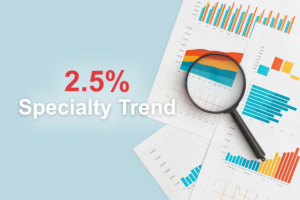- 0.5x
- 0.8x
- 1x
- 1.2x
- 1.5x
- 2x
Employer groups often engage brokers, consultants, or third-party administrators to assist in evaluating and selecting pharmacy benefit plans to offer their plan participants. While these professionals handle much of the detailed work, multiple stakeholders from executive leadership to human resources personnel, are typically involved in the decision-making process, ongoing management, and communication of these benefit plans.
To help stakeholders understand the key components of their pharmacy benefit plans, National CooperativeRx has developed a three-part blog series where we explore pharmacy benefit management concepts at a high level and answer frequently asked questions. In the first part of our series, we will examine costs and access, addressing who manages pharmacy benefits, how costs are determined, and where participants can fill their prescription drugs.
Who Manages Pharmacy Benefits?
Employee benefits professionals commonly turn to pharmacy benefit managers (PBMs) to provide comprehensive solutions for their clients’ pharmacy benefit needs. PBMs specialize in administering prescription drug plans for health insurance plans, employer groups, and other entities. PBMs act as intermediaries between insurers, pharmacies, and drug manufacturers. They negotiate drug pricing, develop and maintain lists of preferred prescription drugs (formularies), establish networks of pharmacies, and handle claims processing (the process of paying for prescriptions when participants use their benefit plan). Additionally, PBMs provide ongoing management and oversight of pharmacy benefit plans, monitoring plan performance to help control prescription drug costs for plans and their participants.
How are Prescription Drug Costs Negotiated?
PBMs negotiate with drug manufacturers to secure favorable discounts and pricing for prescription drugs. Negotiations are often based on various factors, from the volume of drugs purchased to placement on formularies, and rebates. Rebates are essentially cashback rewards that incentivize PBMs to favor specific prescription drugs from manufacturers.
This interplay between quantity discounts, formulary placement, and rebates is a key factor in determining the overall cost of prescription drugs within a pharmacy benefit plan. The final price tag for plan participants, however, depends on the PBMs’ contract with plans or employer groups. PBMs may offer groups pricing and rebates that differ from their negotiations with manufacturers and pharmacies as a source of profit.
What Determines the Out-Of-Pocket Costs for Prescription Drugs?
The actual cost plan participants pay is affected by two key factors within the PBM pharmacy benefit plan: formularies and cost-sharing structures. Formularies are often tiered or categorized based on drug type and cost. These tiers may determine cost sharing, or how much plan participants pay out-of-pocket for their prescription drugs. Cost shares may be copayments (a fixed dollar amount) or coinsurance (a percentage of the drug’s cost). Prescription drugs on lower tiers have lower copayments or coinsurance, while drugs on higher tiers may be more costly for the participant.
PBMs typically create different formularies to accommodate varying needs and preferences within pharmacy benefit plans. For example, some formularies may have a broader range of preferred prescription drugs that vary in cost, while other formularies may have a narrower selection to help steer participants away from high-cost prescription drugs.
Self-funded employer groups choose which formulary approach and cost-sharing structures they want to offer their plan participants through their PBMs.
Where Can Plan Participants Go to Fill Prescription Drugs?
In addition to managing drug pricing and formularies, PBMs establish networks of pharmacies where plan participants can fill their prescription drugs. They negotiate reimbursement rates with these pharmacies to ensure the cost-effective distribution of prescription drugs. Pharmacies in a PBM’s network must adhere to their quality and service standards, providing support and integrated care management programs, which can influence greater medication adherence and treatment outcomes. Pharmacies also provide data and reporting to PBMs, allowing PBMs to monitor utilization patterns, assess pharmacy performance and compliance, and facilitate better coordination of care.
PBM pharmacy networks commonly include major chain pharmacies that are geographically dispersed, providing convenience to participants. More managed networks may cater to specific needs such as long-term medications, larger supply requirements, specialty medications (like those for rare diseases or complex treatments), and services like home delivery. This diversity allows PBMs to meet the unique needs of plan participants while managing costs through their negotiated reimbursement rates within the network.
Employer groups may influence which network(s) they offer their plan participants through their PBMs, such as broader and less managed networks or more limited networks.
Conclusion
PBM pricing negotiations, formularies, and networks play a vital role in determining prescription drug access and costs to plans and their participants. By understanding these elements, stakeholders can better manage their pharmacy benefit plans and educate their employees.
In the next part of our series, we will explore the processes and strategies of pharmacy benefit management, including claims adjudication, utilization management, and more.
Check out our pharmacy benefit glossary for more definitions regarding pharmacy benefits.




